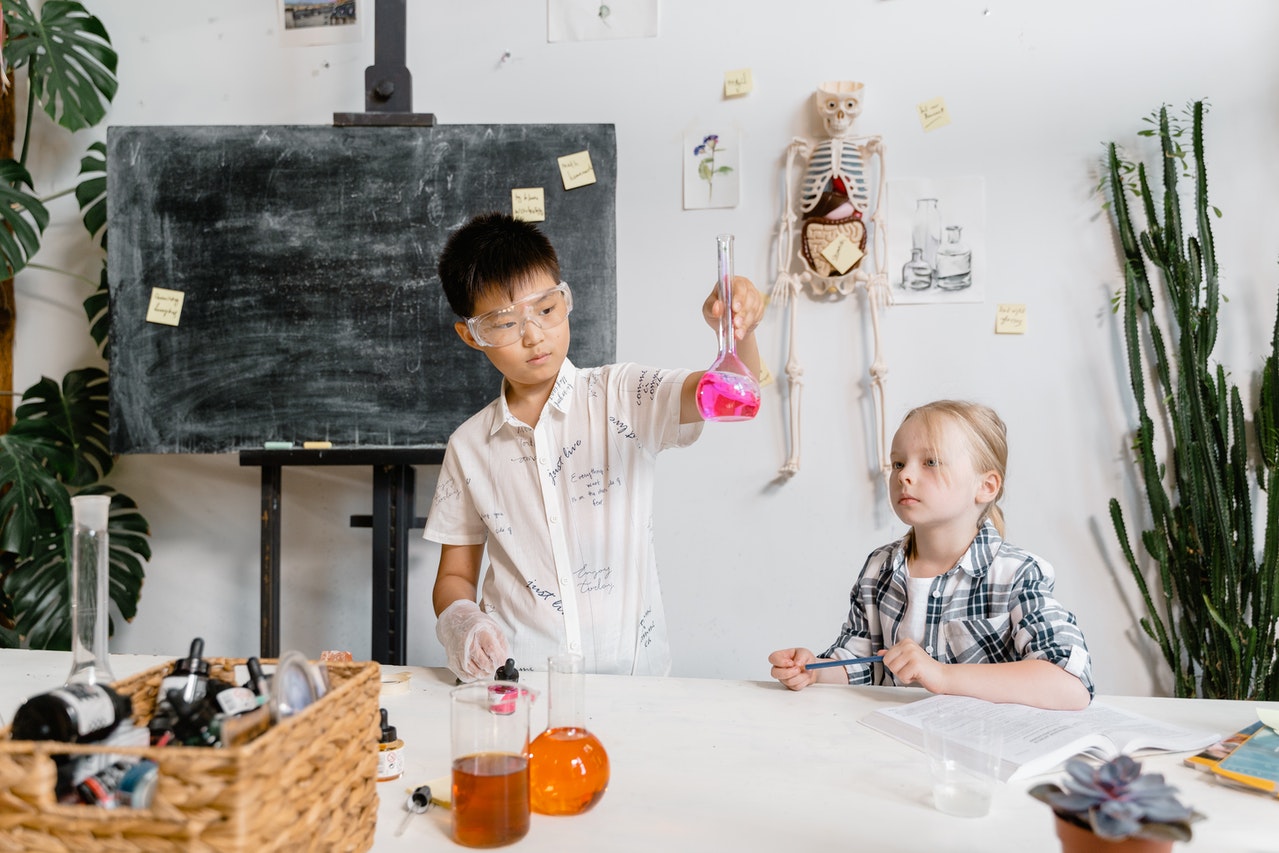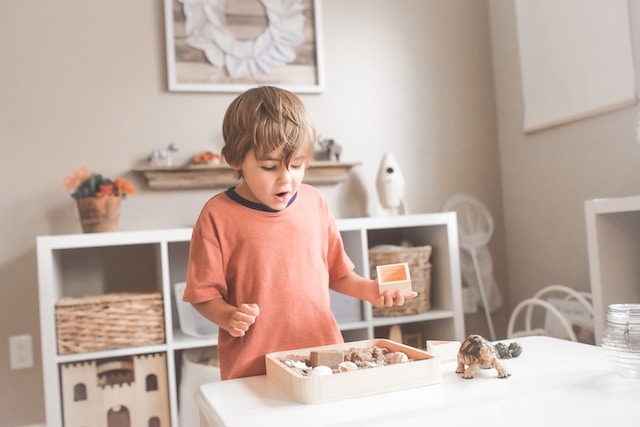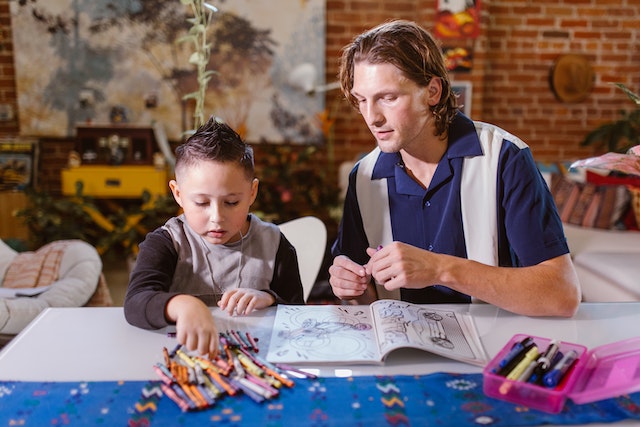The STEAM education program (short for Science, Technology, Engineering, Arts, and Mathematics) is becoming an essential part of the school curriculum. This program helps kids and students develop vital design thinking and problem-solving skills. While schools are teaching the STEM program more and more, there are also ways to implement the program at home, using online materials, household items, and online programs. Doing STEAM activities is a fun way to keep kids learning and spending time together. This article offers tips from experts on how parents can utilize the STEAM program from the comfort of their home by, for example, setting up a dedicated space where kids can do various STEAM challenges.
What are essential items or materials to create a makerspace?
It is important when creating a makerspace to think about who will be using the makerspace and for what purpose. This will help guide what materials and tools you will buy for the space. The most important thing any makerspace educator will tell you is storage! You have to be organized and places to store frequently used materials and infrequently used materials. You need space to store students’ work in progress. Here are some great storage containers that you can find on Amazon:
- Small Plastic Storage Box
- Medium Storage Tote With Lid
- Small Clear Storage Tote With Lid needs to see what’s in the box
- Storage Bin w/Clear Lid
- Slider Pencil Cases for individual storage of projects
The next important thing for a Makerspace is the consumables; things students will use up. These include glue, tape, paint, markers, pencils, paper, pom-poms, and pipe cleaners. Then you want to think about the tools students will use. Tools that get reused over and over again are usually not part of the final project and can be shared among Makerspace participants. Tools include scissors, hot glue gun, hammer, tape measure, ruler, drill, screwdriver, box cutter, 3D printers, band saw, drill press, laser engraver, and so much more. Once you have thought about all of this, you can begin to think about what materials will be needed for projects – batteries, electric tape or wire, cloth, robots, filament, wood, arduino, makey makey, microbit, LEDs, amongst many more.
– Liz, WhyMaker
What is a simple STE(A)M activity for young children to develop problem-solving skills?
The most powerful STEM activity for children of any age is the 5 Whys. Originally developed by Toyota as part of their quality assurance program, the 5 Whys is the world’s easiest way to develop problem-solving skills. To do this activity, all you need to do is ask “Why?” five times! Simply pose a question, then ask why 5 times for each response. In doing so, students learn how to dig deep and identify the root cause, which in turn enables anyone to solve any kind of problem, anytime, anywhere. Not only is it super easy, but the 5 Whys is also widely applicable across all domains within STEM and beyond. Further, it can be effortlessly implemented by both educators and parents alike. For example, “Why are you interested in science?” would be a great dinner table conversation tonight in your household!
– Ashley, Career in STEM
What is a STEAM challenge that kids can conduct in their kitchen?
Activity: “Which fruits or vegetables sink/float in water?”
One easy and accessible experiment that can be done right in your kitchen is a float or sink experiment! All you need to gather is fruits and vegetables you have in your kitchen and a sink, bathtub, or bowl filled with water (preferably a bowl that is large enough to show a watermelon floating– which may catch kids by surprise!) First, prompt kids to think about what they predict might happen for each fruit/vegetable. You can even give them sentence starters to help prompt specific scientific vocabulary (e.g., “I predict that the apple will float”, “I hypothesize that the watermelon will sink”). Place fruits/vegetables in water one by one and observe what happens! Make sure to remind kids that it is more than okay to have your hypothesis be incorrect because it is a great learning moment for them, and they can correct their prior knowledge with actual observations. This experiment helps get kids thinking about density. You can introduce to kids how fruits/veggies denser than water will sink, and those that are less dense will float (more vocabulary for them to get familiar with). If kids are a bit older, you can share that the density of water is 1 g/cm3. So fruits/veggies that float have a density less than 1 g/cm3, and ones that sink have a density greater than 1 g/cm3.
– Fatoumata, Ivy Camps USA

How can parents support their children with STE(A)M education at home to develop their innovator mindsets?
Science, Technology, Engineering, Art & Design, and Mathematics (STEAM) is everywhere! Parents should leverage this and help the children cultivate their STEAM mindsets in their everyday lives. Getting specialized STEAM toys and kits is a wonderful thing to do as well, but it does not substitute for the wealth of opportunities provided by building a growing awareness of embedded STEAM concepts in everyday life. That age-old relevance question, why do I need to know this, can be easily addressed by building this growth mindset. You don’t need to be any type of expert. Instead, use the technique that all scientists, STEAM practitioners, and innovators use- ask questions!
At the playground, what are the different ways you can get the swing to move? Why does your body move faster down one slide than the other? How many different shapes do you see on that climbing structure? At the park, which are the shadiest areas of the park? How long and wide is the field? How can I measure using just my stride length? How can I estimate the height of that tree? At home, does my cat or dog use a mathematical pattern when they walk? Do I hear any math patterns when I listen to or play music? During design or building projects, what’s the best angle for the table leg, and how can I make sure I get it right? The list goes on. These questions are all based on what is observable. In other words, get into the habit of asking questions about what you notice – no major background knowledge necessary. Of course, all this boils down to getting in the habit of noticing what is around you. Make a game out of it – how many questions can you come up with, and how many questions can I come up with? Then, how could we answer some of these questions? Here, the focus is not on getting the right answer – rather, the focus is on coming up with a good strategy.
We do this type of thing all the time through our walkSTEM initiative and would love to invite you to join us! Check out this short video we made in partnership with the Dallas Zoo, where we tried to answer the question about the walking patterns of some of our four-legged friends!
This video was made in partnership with Southern Methodist University, with support from the National Science Foundation
– Dr. Koshi Dhingra, talkSTEM
What tips help kids develop their interest in technology from home?
During COVID, kids and adults alike had to find new ways to keep themselves busy at home and keep going about their life without sacrificing all the fun! For kids, parents and educators can introduce many activities that are not only enjoyable but also help them learn in the process. There are several pedagogical tools and assistance available on the internet which can help the little ones to learn more about the world around them, such as online videos with colorful graphics and cartoons, puzzles, learning games, etc. If you want the younger kids to get more involved with coding, there are coding toys available to understand the process in baby steps. For older individuals, YouTube videos, coding games, and online study applications can be useful. For those who like books, critical and computational thinking can be encouraged with the help of coding in Scratch, via storytelling, avoiding difficult jargon, attractive illustrations, etc. Besides, the Tran-SET website lists multiple resources that can be helpful for kids to explore STEM fields at home. Students can get involved in several at-home activities based on their grade levels. To know more about learning resources, events, and activities for kids, parents, and educators, please check out the Tran-SET website.
– Heena, Tran-SET
What is a simple math activity kids can do in their garden?
How can children’s creativity be stimulated at home?
Education doesn’t stop at the end of the school day or when a child walks out the schoolhouse doors. In fact, some of the most stimulating, memorable, and creative learning takes place at home.
The acronym STEAM highlights skills that work together to make our world a better place. Science, Technology, Engineering, Arts, and Math are used worldwide every day to create bridges and ice cream, restore broken bones and historic artifacts, and deliver Wi-Fi and pizza to your home. Those same STEAM skills can be encouraged at home to help a child become more creative.
Stories: Talk about the STEAM you see, use, and experience in your daily lives
Trips: Visit the places where STEAM is used, like museums and businesses
Action: Find ways to improve your community using STEAM, like starting recycling or gardens
Exploring: Discover STEAM in the natural world by going outside
Making: Create something using STEAM skills, like baking cookies or fixing a broken toy
Design a board game. Fix a bike. Make a movie. Plant some seeds. Try a new recipe. Build something with cardboard boxes. No matter what you choose to do, time together with your children will make a huge difference.
– Chris, dailySTEM
What is a STEAM challenge that kids can conduct at home, using simple materials?
An easy STEAM challenge kids can do at home is to build an invention. Provide kids with a simple prompt “What could you invent?”. The process of inventing allows kids to express their innate ability to be creative. It creates an opportunity to build skills such as observing, critical thinking, tinkering, and storytelling. Every good invention solves some problem. With this mindset, inventing provides opportunities for kids to build valuable empathy skills. “What could I invent that could help someone?”, “What could I invent that could solve an everyday problem?”. Inventing teaches kids to be problem-seekers. Once kids have an idea, encourage them to build a rough prototype—a physical representation of their invention that does not need to function. Kids can construct these prototypes with materials like LEGOs, KNEXs, Strawbees, typical arts & crafts supplies, and other miscellaneous objects/building toys. Prototyping allows creative kids to engage in imaginative play. Looking to make this a whole family event? Create an invention competition similar to the hit TV show Shark Tank. Instruct kids to create a pitch to present their inventions, including rough prototypes, to a panel for “funding”!
– Ryne, Fluxspace
What is a fun game or activity that can help kids develop their engineering skills?
How can kids apply DroneBlocks at home, and what are its benefits to the STEAM education?
Drones are not only a fun and engaging tool, but their applications in education are proving to be extensive and inclusive. DroneBlocks creates opportunities for students of all ages to learn Blockly, Python, and JavaScript by programming autonomous drone missions in the classroom. DroneBlocks offers everything educators need to launch a STEAM drone program including drones, curriculum, software, and professional development. Students at home can download DroneBlocks for free on either the iOS, Google Play, or Chrome app stores.
– David, DroneBlocks
What are some STEM toys kids can use at home to practice science?
A good STEM toy triggers both sides of the brain when children engage with them. The left, logical, and reasoning side of the brain is activated when the experience instills concepts of science, technology, engineering, or math. Whereas the right side of the brain, or the emotional side is sparked when there’s fun and creativity involved.
Depending on the age of the child, a good toy could be as simple as building blocks which are to be stacked one on top of the other to give kids an intuitive understanding of balance, strength, and stability. And for older kids, you could consider slightly more complicated construction kits that introduce your child to concepts like gears, pulleys, and levers. Smartivity offers wonderfully designed wooden construction kits with incredibly detailed easy-to-follow instruction manuals. You would be astounded to watch your child navigate his/her way through the instructions to assemble a beautiful working model that uses scientific concepts; the intricacies of which they would learn much later in life.
– Apoorv, Smartivity
How can coding for kids foster problem-solving skills and critical thinking abilities that are essential in today’s digital world?
When children learn coding, they are essentially learning how to build things from scratch, and how to solve any problem that comes in between in achieving that goal. It is not that coding is the only way to learn problem-solving skills, but it is probably the most effective and relevant way for children today. For example, when a child is writing code to build an application, the child is thinking about the various types of variables, programming constructs, and the most efficient logic to use among multiple ways to solve that problem. Programming can be used by children to learn to build visual interface-based games, apply linear algebra and geometry together in the program logic, imagine mathematical topics such as ‘differentiation’ and ‘3D spaces’ that are otherwise difficult to do, and build applications such as websites and apps that you see around. Coding helps children understand what is going on behind the scenes and learn problem-solving and computational thinking to build products.
As kids learn to program and use it to build various applications, their points of view of technology start to change from being a passive ‘consumer’ of technology to having an active point of view of a ‘creator’. For example, a simple technology that translates an image of text written in one language into another language is used by one child as a passive tool, but the same technology, when experienced by another child who has an understanding of programming, knows that it uses an optical character recognition program and a translator program to build it. So, the essential view of the world for the child will change for the better in terms of their confidence, problem-solving, persistence, creativity, and algorithmic thinking, enabling them to build a creator’s mindset.
Sai Balivada from UnicMinds
What are the benefits of art therapy?
Art therapy is a mental health profession that involves art making and the creative process to help improve cognitive and sensory-motor functions, build and improve social skills, promote self-esteem and improve emotional expression.
Children’s art therapy is often confused with play therapy. While play therapists may use some art-based activities in their sessions when suitable, Art Therapy specifically uses art media to help children visually express emotions and communicate through creative expression.
Art Therapy allows children to communicate their thoughts and ideas visually and without using words. This makes it particularly helpful for treating children with varying special needs.
Art therapy can be beneficial for children who are:
- Struggling with emotional expression
- Struggling to communicate
- Suffering low self-esteem
- Having difficulty self-regulating
- Struggling with socialization/social skills
- Experiencing difficulty with sensory integration (over or under-stimulated)
- Diagnosed with Autism
- Experiencing Anxiety
- Diagnosed with ADHD
- Experiencing communication difficulties
– Annie Tao, Always Keep Progressing

Creating a secure learning environment
It’s essential to consider the safety and security of the learning environment. While the focus is on fostering creativity, problem-solving, and innovation, a secure setting is crucial for peace of mind.
Here are some tips to create a safe space for your young innovators:
- Supervision: Always keep an eye on your child during STEAM activities. This ensures they can explore and learn freely while staying protected
- Childproofing: If you have younger children, make sure your learning space is childproofed. Secure sharp objects, chemicals, and other potential hazards out of their reach
- Digital safety: When using online materials and programs, set up parental controls and ensure your child understands online safety rules, like not sharing personal information
- Home security: Invest in a reliable home security system. You can find a variety of options to suit your needs, from basic doorbell cameras to more comprehensive setups. These systems can provide both safety and peace of mind while your child enjoys STEAM activities
The STEAM education program is an excellent way to help kids develop new skills while having fun. These activities are for kids to discover themselves or the whole family to enjoy! Whether you want to set up a playroom, learn how to code with Python, look for fun activities using materials you probably already have at home, or switch up your homeschooling, feel free to use the tips and advice provided in this article.




